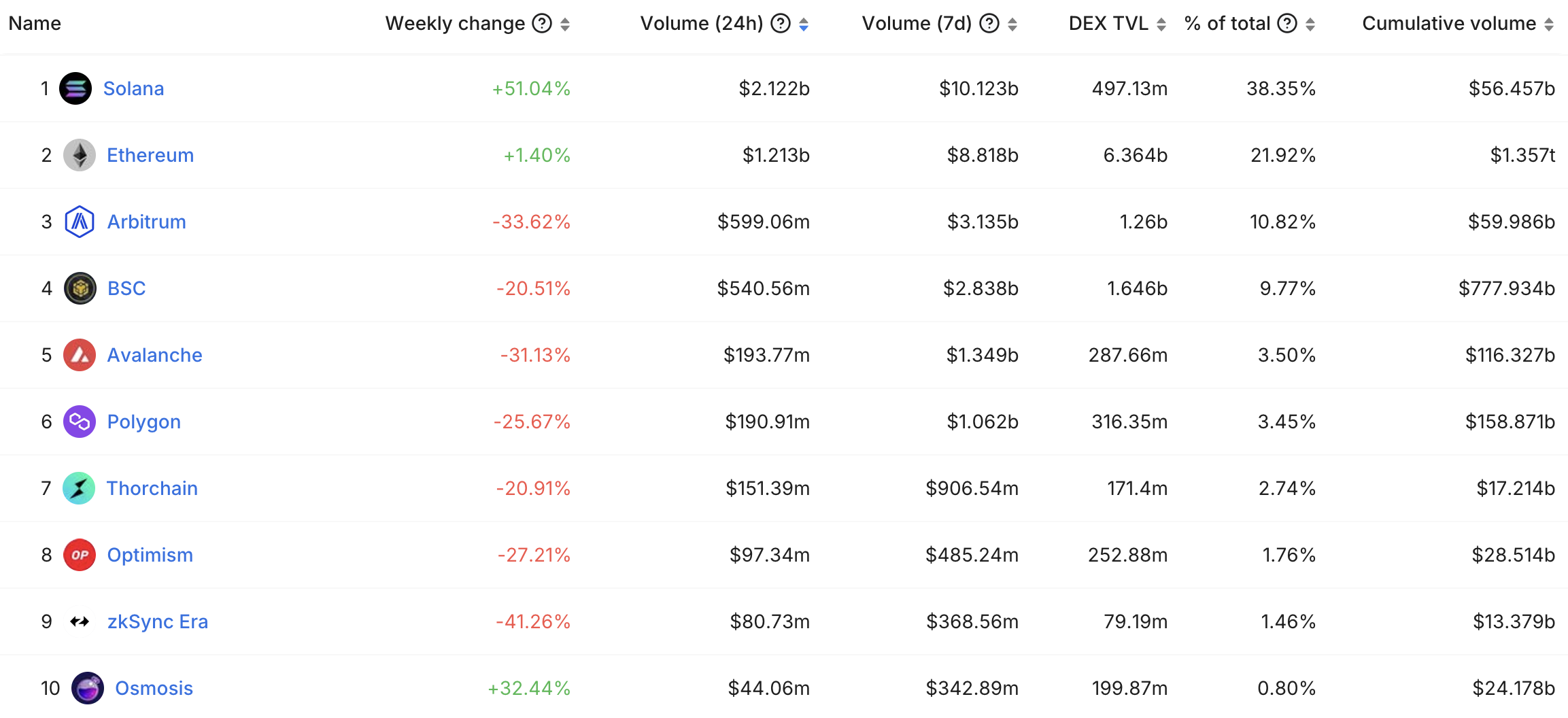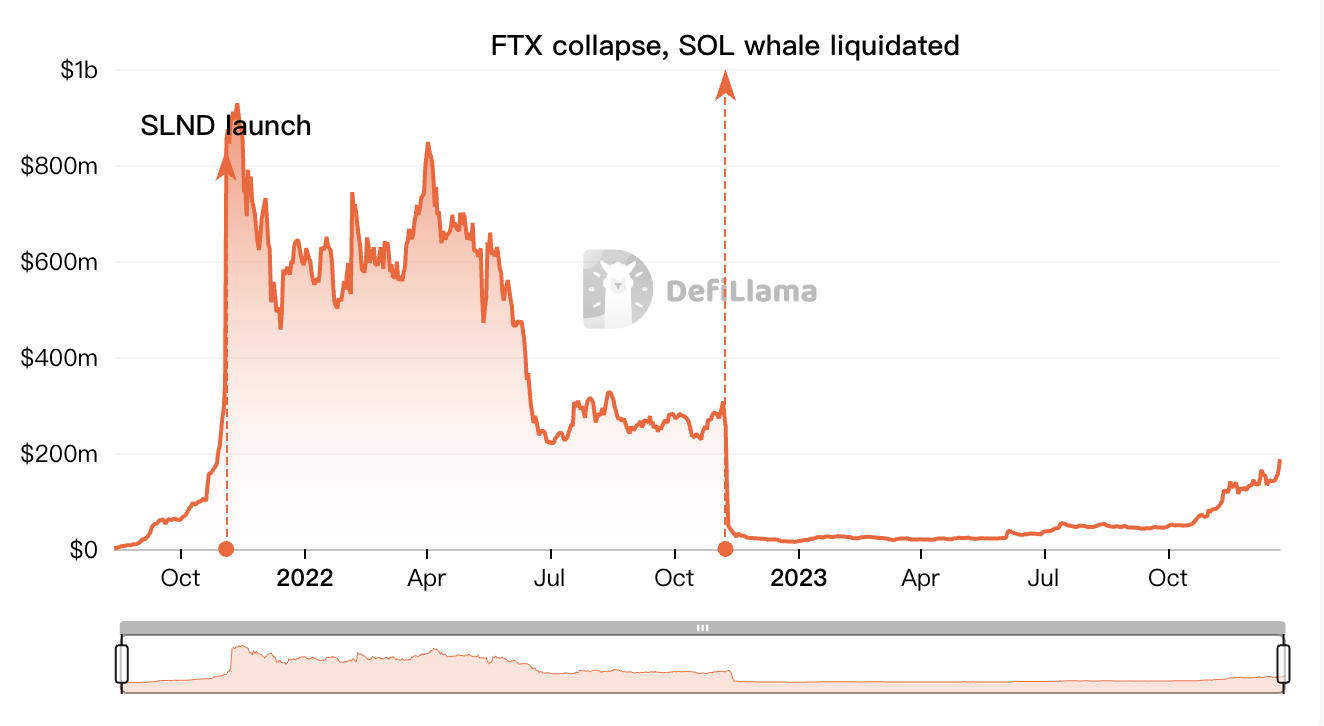The Solana ecosystem has shown strong performance driven by DePIN and MEME coins, with SOL's price rising to nearly $100 on December 22nd. The trading volume on Solana's DEX briefly surpassed that of Ethereum, leading to a growing call for "Solana Flip Ethereum".
Meanwhile, Ethereum has begun to face various FUD, especially as the DeFi projects that led the previous bull market on Ethereum are no longer favored due to the liquidity mining method. In addition to the recent popularity of MEME and DePIN, how have DeFi projects on Solana performed? Have older projects truly recovered?
Liquidity Staking
Liquidity staking is an important growth project on Solana. Staking itself locks up funds, benefiting the rise of SOL, and various liquidity staking tokens (LST) can be applied in other DeFi projects. The wealth effect and incentive measures from new project airdrops also continue to drive the growth of funds participating in liquidity staking.
The largest liquidity staking projects on Solana are Marinade Finance and Jito. According to DefiLlama data as of December 22nd, their TVL is $1.05 billion and $626 million respectively, ranking them as the top two in Solana's ecosystem.
Although the USD value of funds staked in Marinade is only 57% of its peak, the amount of staked SOL (11.15 million SOL) has reached a historical high.

In addition to staking, Jito also provides MEV infrastructure and has gained a good user base due to unexpected airdrops. With the start of incentivizing the use of JitoSOL in DeFi projects, the amount staked in Jito continues to grow rapidly, currently at 6.42 million SOL.
Decentralized Exchanges (DEX)
The two most important projects in the DEX race are still Raydium and Orca, with no outstanding new projects emerging. They have also developed centralized liquidity features based on their original foundations, but their positions have reversed.
For DEX, liquidity and trading volume are the most important indicators. Raydium's highest liquidity was $2.21 billion, currently at $1.13 billion, only 5.1% of its peak. Orca's highest liquidity was $1.41 billion, currently at $1.84 billion, only 13% of its peak.
Recently, there has been a focus on the data showing Solana's DEX trading volume surpassing that of Ethereum. As shown in the DefiLlama data below, Solana's trading volume has been higher than Ethereum's in the past 24 hours and 7 days. Although some have questioned this, suggesting that it may be due to the repeated calculation of the trading volume of the trading aggregator, Solana's reliance on the trading aggregator (Jupiter) is higher than Ethereum's (1inch), resulting in more repeated calculations.

However, according to the trading volume calculated by DefiLlama for various DEX on Solana, the total trading volume of Raydium, Orca, Lifinity, Phoenix, OpenBook, Mango Markets, Drift, and Saber in the past 24 hours is $1.55 billion. This does not include the trading volume of perpetual contracts like Drift, which has a spot trading volume of $7.6 million, but the trading volume of SOL-PERP alone is $43 million.
On the other hand, the total trading volume of Uniswap, Curve, Balancer, PancakeSwap, DODO, Tokenlon, Maverick, and Sushi on Ethereum is $1.18 billion. This indicates that on November 21st, the trading volume on Solana's DEX was indeed higher than that on Ethereum. It is also worth noting that the trading volume on Ethereum is mainly concentrated in Uniswap ($9.4 billion), followed by Curve ($1.4 billion), with the remaining trading volumes being around $20 million or lower.
Another recently mentioned metric is the trading volume/TVL of DEX, which reflects the utilization of funds. Raydium and Orca have ratios of 4.81 and 2.87 respectively, while Uniswap, Curve, and Balancer have ratios of 0.26, 0.09, and 0.042 respectively. Liquidity providers currently mainly provide liquidity to earn trading fees, indicating that the income from providing liquidity on Solana is much higher than on Ethereum with the same principal, which may attract further funds into the Solana ecosystem.
Decentralized Lending
The decentralized lending race has seen significant changes, with only Solend, which used to have a large amount of funds, still ranking high. However, it has also been surpassed by newcomers. TVL is equally important for lending protocols, representing how much remaining funds (deposits - loans) are still in the protocol. More remaining funds also mean more deposits.
Solend's highest TVL was $9.1 billion, currently at $1.87 billion, equivalent to 20.5% of its peak. Solend suffered a setback in November 2022 due to the collapse of FTX, with TVL dropping 90% from $280 million at the beginning of the month. The performance of other established lending protocols has been even worse, with Port Finance's TVL dropping from $260 million to $5.7 million, Larix's TVL dropping from $360 million to $4.81 million, and Apricot Finance's TVL dropping from $350 million to $2.5 million.

This race has also seen the emergence of a new batch of competitors. The TVL of marginfi and Kamino is $348 million and $204 million respectively, and they have been growing rapidly recently. They have not issued governance tokens yet and have introduced a point system, allowing deposits and loans to earn points. With the wealth effect from airdrops like Pyth and Jito, funds continue to flow in, and various LST can also receive support, while liquidity staking projects may provide additional incentives for these funds.
Yield Aggregators
The yield aggregator race has almost been debunked, as Solana does not require high fees like Ethereum, and investments through yield aggregators can automatically reinvest, avoiding personal operation fees.
The most famous project in this race on Solana is Sunny, which had a peak TVL of $3.4 billion, currently at only $4.02 million. Sunny is usually used in conjunction with Saber, and the developers behind these two projects have been exposed as the same person who has forged 11 identities to develop different projects, inflating Solana's TVL by billions of dollars.
In addition to simple yield farming functions, some yield aggregators also provide lending and leveraged mining functions, but due to the decrease in mining income, the performance of these projects has also been poor. Francium's TVL dropped from $430 million to $20.89 million, and Tulip's TVL dropped from $1.07 billion to $21.41 million.
Perpetual Contracts
Compared to various perpetual contract projects on Ethereum Layer 2, Solana's performance in this race is not particularly good.
Currently, the most comprehensive project in this field is Drift, which mainly uses an order book trading model similar to dYdX and can use leverage of up to 20 times. The project has set a new high TVL of $105 million, with a SOL-PERP trading volume of $43 million in the past 24 hours. The project also has a way to trade spot leverage.
Mango is an older project in this race, with TVL dropping from a peak of $210 million to $10.47 million. It was previously attacked by hackers in a market manipulation scheme, and the hacker was later sued and arrested. Mango mainly involves borrowing and leveraged trading, requiring borrowed funds to be traded through Jupiter. Mango has also added perpetual contract trading, with only $520,000 in trading volume for SOL-PERP in the past 24 hours.
Another competitor in this race is Jupiter's JLP, which follows a similar model to GMX V1. JLP has a capital limit of $23 million, with a SOL-PERP trading volume of $101 million in the past 24 hours, even surpassing Drift.
Decentralized Stablecoins
Solana has not had any outstanding projects in decentralized stablecoins from start to finish.
UXD Protocol is a representative example, which completed a 1D0 with a valuation of nearly $2 billion, but its TVL only reached $42 million at its peak and is currently at $11.19 million. Initially, it hedged SOL collateral in a Delta-neutral manner, but now it has also shifted to minting USDC at a 1:1 ratio.
There are also two stablecoin projects using over-collateralization for minting, but they have also declined. Parrot Protocol had a peak TVL of $476 million, currently at $8.61 million; Hubble had a peak TVL of $39.83 million, currently at $8.06 million.
Conclusion
This article discusses the development of various DeFi projects on Solana, with liquidity staking projects leading the growth of Solana's TVL, and various LST tokens can be used in other projects and receive incentives. The liquidity in DEX lags far behind Ethereum, but the trading volume sometimes exceeds that of Ethereum's DEX, driven by the extremely high capital efficiency in Solana's DEX, which may further attract funds to Solana. Newcomers marginfi and Kamino have performed well in the decentralized lending field, with expectations of airdrops. Drift and JLP are growing in the perpetual contract field, but there are no outstanding projects in the yield aggregator and stablecoin fields.
免责声明:本文章仅代表作者个人观点,不代表本平台的立场和观点。本文章仅供信息分享,不构成对任何人的任何投资建议。用户与作者之间的任何争议,与本平台无关。如网页中刊载的文章或图片涉及侵权,请提供相关的权利证明和身份证明发送邮件到support@aicoin.com,本平台相关工作人员将会进行核查。




